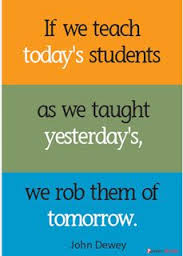
It is hard to imagine our world with out the technology aided conveniences that we have become accustomed to. As a 5th grade teacher, my students often look shocked and extremely sad for me when I tell them that my family did not get our first computer until I was a junior in high school, or that I did not own a cell phone until my senior year of college and that GASP!!! it only made calls and sent texts sans emojis. Today, I cannot imagine a world where Google is not within my reach to answer any question or wondering. I feel that the availability of information has made it easier for me to be a lifelong learner. As I have embraced the possibilities that technology can offer in my personal life it is imperative that I change my mindset about how I approach the role of technology in my classroom. I work in an elementary school that still has a no cell phone/no device rule for students as a whole. I have gone against this to allow devices in my classroom while respecting the school rule and not allowing them outside of my door. I often think of a powerful statement that I heard at a technology conference a couple of years ago, it was something to the effect that students engage with technology all day, everyday outside of our classrooms and to prohibit them from using it to engage in learning makes learning old fashioned, less desirable, not relevant to what is important to them.
I identify strongly with the constructivist approach to learning. I recently finished a graduate certificate program in mathematics from Boise State University where the emphasis was not just on math as a discipline, but through a constructivist perspective on how to help kids make meaning and relevance in mathematics, often this is done through authentic learning opportunities where the teacher is a facilitator not a lecturer. This shift in paradigm applies to my vision of how potentially powerful integrating technology in my classroom will be. My vision would be to provide authentic learning opportunities to my students and allow them to harness the power of technology to construct meaning in their world of the concepts we are learning about. I want to change the way that I think about teaching in my classroom, and hopefully be a teacher leader that helps other teachers change the way that they teach too. The 2016 NMC/CoSN Horizon Report on K-12 education discusses that one solvable challenge facing education today is to rethink the role of teachers. A teacher's primary responsibility is no longer to provide expert-level knowledge, but to construct learning environments that help students gain 21st century skills. At the heart of this paradigm shift is me! A teacher! I feel that it is imperative that I, and my fellow teachers, focus our efforts not on shaping excellent mathematicians or excellent writers, but on training a future generation of flexible, digitally literate, innovative, and collaborative individuals who will harness the knowledge and tools available to them and take us to places we cannot even imagine. Roblyer, M. (2016). Integrating Educational Technology into Teaching (7th ed.). Massachusetts: Pearson. NMC/CoSN Horizon Report > 2016 K-12 Edition retrieved from nmc.org
0 Comments
Leave a Reply. |
AuthorMy name is Rebecca Davis. I love learning and I hope to inspire the next generation to do the same. Archives
April 2017
Categories |
 RSS Feed
RSS Feed
